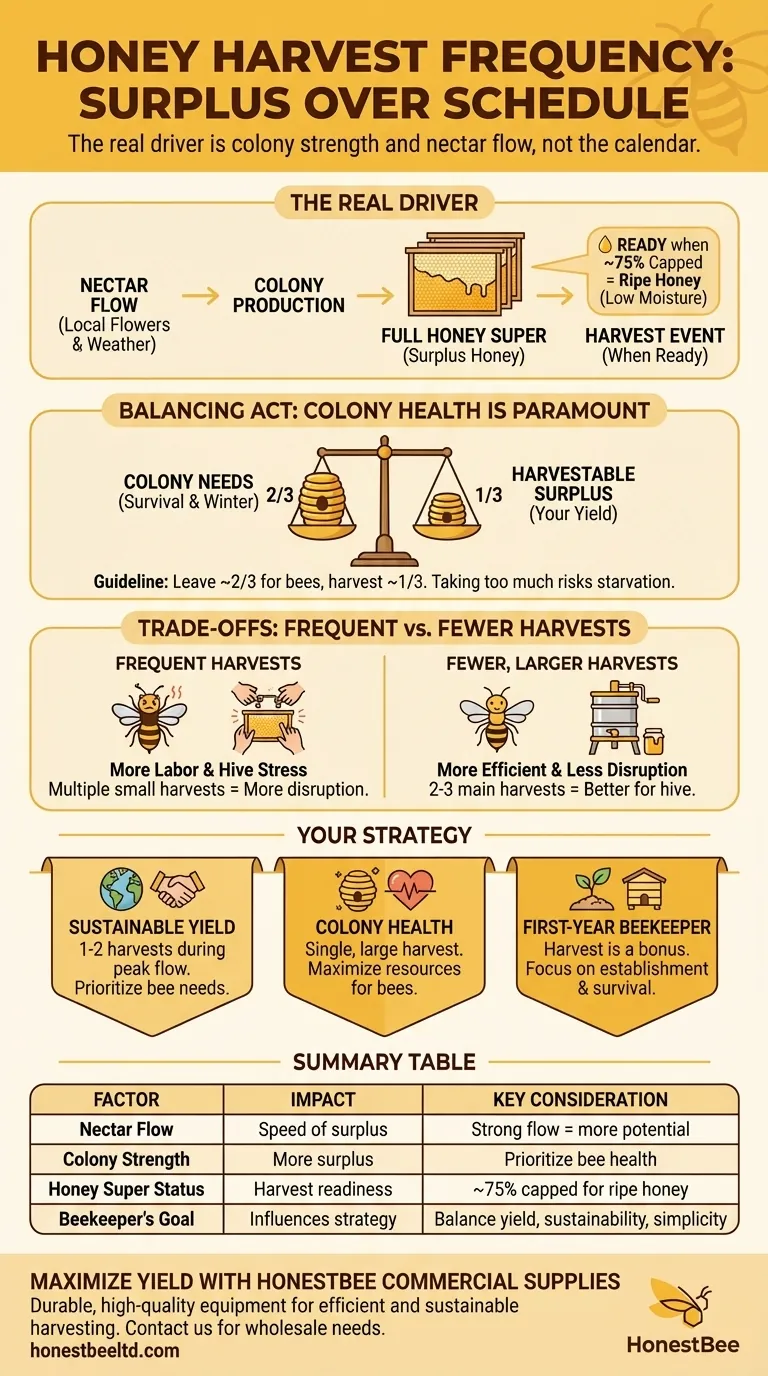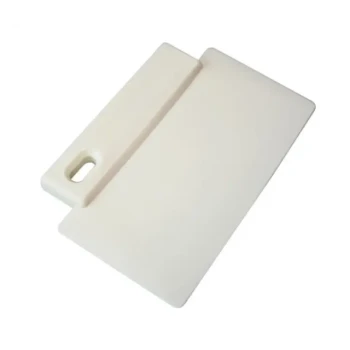The frequency of honey harvesting is not determined by a calendar, but by the strength of your bee colony and the availability of local nectar. While it's technically possible to harvest anytime you have a full honey super, most beekeepers find that two or three harvests per year strikes the right balance between yield and sustainability.
Your goal is not to harvest a set number of times, but to harvest the surplus honey your bees produce. The number of harvests is simply a result of how quickly they create that surplus, which can change dramatically from one year to the next.

The Real Driver of Your Harvest Schedule
Thinking in terms of harvest "events" rather than a rigid schedule is the key to successful and responsible beekeeping. The bees and the environment dictate the timeline.
It's About Surplus, Not the Calendar
You can only harvest honey that is in excess of the colony's own needs. The primary trigger for a harvest is the presence of a full honey super—a box on the hive dedicated solely to honey storage that the bees have filled.
What Makes a Super "Ready"?
A super is ready for harvest when the bees have filled the comb with honey and "capped" it with a thin layer of beeswax. This capping process signifies that the honey is ripe, meaning its water content is low enough to prevent fermentation.
You should look for frames where the honeycomb is at least three-quarters capped over. Harvesting honey that isn't capped can lead to spoilage.
The Role of Nectar Flow
The speed at which your bees produce surplus honey is entirely dependent on the nectar flow. This is the period when local flowers are producing abundant nectar.
A strong, prolonged nectar flow (driven by good weather and blooming plants) might allow for multiple harvests in a single season. A weak or short flow may only yield a single, smaller harvest, or sometimes none at all, especially for a new colony.
Understanding the Trade-offs
More harvests do not always equal a better outcome. Aggressive harvesting can create more work for you and put unnecessary stress on the colony.
Colony Health is Paramount
The most critical rule in beekeeping is to ensure the bees have enough food to survive. A common guideline is to harvest only about one-third of the available honey, leaving the remaining two-thirds for the bees.
Taking too much, especially before winter, can starve the colony. Their survival is your first priority.
The Practical Cost of Frequent Harvests
Every harvest is a labor-intensive event. It involves removing heavy frames, transporting them, uncapping the honey, using an extractor to spin it out, and then cleaning all the sticky equipment.
This is why most experienced beekeepers aim for fewer, larger harvests. It is more efficient and causes less frequent disruption to the hive.
How to Determine Your Harvest Strategy
Your approach should align with your primary goal as a beekeeper.
- If your primary focus is a sustainable yield: Aim for one or two main harvests during the peak summer nectar flow, always prioritizing leaving enough honey for the bees.
- If your primary focus is colony health and simplicity: Be content with a single, large harvest per year, ensuring you leave more than enough resources for the colony to thrive through winter.
- If you are a first-year beekeeper: Consider any harvest a bonus. Your primary goal is to help the colony establish itself, build up its population, and survive its first winter.
Ultimately, successful honey harvesting is an exercise in observation and responsible stewardship of your hives.
Summary Table:
| Factor | Impact on Harvest Frequency | Key Consideration |
|---|---|---|
| Nectar Flow | Determines speed of surplus production | Strong flow = more potential harvests |
| Colony Strength | Stronger colonies produce more surplus | Always prioritize bee health over yield |
| Honey Super Status | Harvest only when frames are ~75% capped | Ensures honey is ripe and won't spoil |
| Beekeeper's Goal | Influences harvesting strategy | Balance between yield, sustainability, and simplicity |
Ready to maximize your honey yield with the right equipment?
At HONESTBEE, we supply commercial apiaries and beekeeping equipment distributors with the durable, high-quality supplies needed for efficient and sustainable harvesting. From honey supers to extractors, our wholesale-focused operations ensure you have the tools for success.
Contact our team today to discuss your beekeeping supply needs and let us help you build a more productive operation.
Visual Guide

Related Products
- Stainless Steel Honey Press Wax Press with Tank
- Stainless Steel Manual Honey Press with Guard for Pressing Honey and Wax
- Electric Flatting and Embossing Machine with Tray for Beekeeping
- Honey Wax Separating Wax Press with Metal Screw Wax Separator Machine
- Professional Wide Blade Honey Scraper for Beekeeping and Honey Processing
People Also Ask
- How does the press method for extracting honey work? A Simple, Low-Cost Guide for Beekeepers
- How was the honey press cleaned after use? Quick vs. Deep Cleaning Methods Explained
- What are the multipurpose functionalities of a honey press? Versatile Harvesting for Beekeepers & Homesteaders
- What are the key features of a honey press? Maximize Yield with Durable, Efficient Extraction
- What are the uses of honey in various industries? Unlock Its Functional Power in Food, Pharma & Cosmetics



















